
Баку
Баку — столица и крупнейший город Азербайджана, а также крупнейший город Каспийского моря и Кавказского региона. Баку расположен на 28 метров (92 фута) ниже уровня моря, что делает его самой низкой национальной столицей в мире, а также крупнейшим городом в мире, расположенным ниже уровня моря. Баку расположен на южном берегу Апшеронского полуострова, рядом с Бакинским заливом.
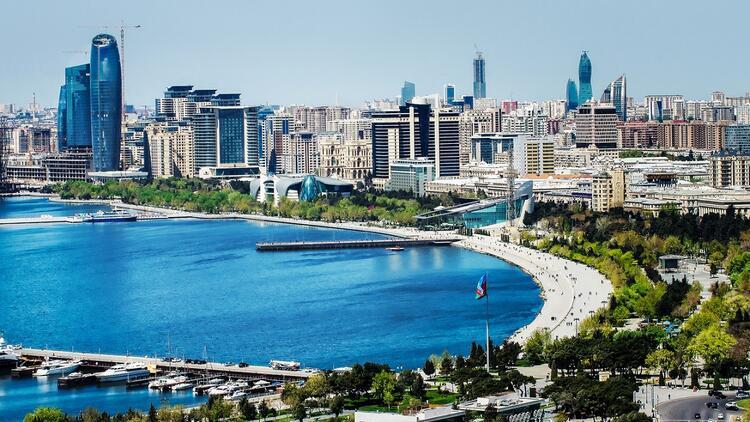

переулок мучеников
Место захоронения турок-азербайджанцев и турок-турок, погибших в Бакинской битве в 1918 году. В период с 1924 по 1990 годы название Хиябана было изменено, большевики построили здесь развлекательные комплексы и изменили его название. После события «Черный январь» в 1990 году этот район снова назвали «Переулком мученико

В 1990 году люди, собравшиеся на Бакинской площади в знак протеста против резни и изгнания турок в Армению и оккупации Арменией азербайджанских земель, были расстреляны советской армией, вошедшей в Баку.
Старый город (внутренний город или город-крепость)
Старый город или Внутренний город — это историческое ядро Баку, столицы Азербайджана. Старый город — самая древняя часть Баку, окруженная стенами, которые легко оборонялись.
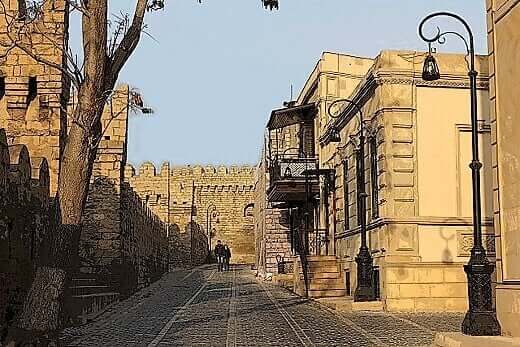
Девичья башня (Баку)
Девичья башня — памятник 12 века в районе Старого города (город Ичери) Баку. В 2001 году он был включен в Список исторических памятников Всемирного наследия ЮНЕСКО. Это один из самых отличительных национальных гербов Азербайджана, поэтому он изображен на азербайджанских денежных знаках и официальных бланках. В Девичьей башне находится музей, в котором представлена история исторической эволюции города Баку. В нем также есть сувенирный магазин. С крыши открывается вид на аллеи и минареты Старого города, Бакинский бульвар, дом Иса бека Гаджинского и широкий вид на Бакинскую бухту.

Башня окутана облаком тайн и легенд, уходящих своими корнями в историю и культуру Азербайджана. Действительно, некоторые былины стали сюжетом для балетов и театральных постановок. «Девичья башня» (балет) – азербайджанский балет мирового уровня, созданный Афрасиабом Бадалбейли в 1940 году, ремейк балета был поставлен в 1999 году. В результате отступления морской береговой линии Каспийского моря появилась полоса суши. Эта земля была освоена между 9-м и 15-м веками, когда были построены стены старого города, дворец, включая огромный бастион Девичьей башни.
Дворец Ширваншахов
Дворец Ширваншахов — дворец 15 века, построенный Ширваншахами и описанный ЮНЕСКО как «одна из жемчужин азербайджанской архитектуры». Он расположен во внутреннем городе Баку, Азербайджан, и вместе с Девичьей башней образует ансамбль исторических памятников, включенных в Список исторических памятников Всемирного наследия ЮНЕСКО. В комплекс входят главное здание дворца Диванхане, усыпальницы, шахская мечеть с минаретом, мавзолей Сеида Яхья Бакуви (так называемый «мавзолей дервиша»), южная часть дворца, портал в восток, ворота Мурада, водохранилище и остатки бани. Раньше рядом с мавзолеем была старинная мечеть. К западу от гробницы до сих пор сохранились руины бани.
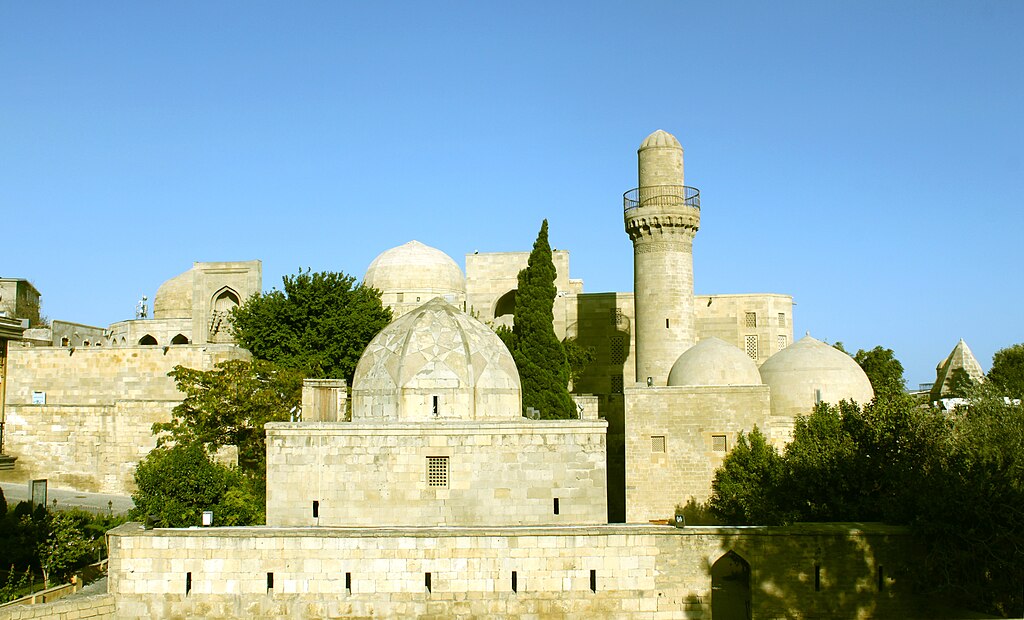
В прошлом дворец был окружен стеной с башнями и, таким образом, служил внутренним оплотом Бакинской крепости. Несмотря на то, что в настоящее время на поверхности не сохранилось следов этой стены, еще в 1920-х годах остатки, по-видимому, фундамента башни и связанной с ней части стены можно было различить на севере- восточная часть дворца.
На самом дворце не сохранилось никаких надписей. Поэтому время его постройки определяется датами в надписях на архитектурных памятниках, которые относятся к дворцовому комплексу. Две такие надписи полностью сохранились только на усыпальнице и минарете шахской мечети. В обеих надписях есть имя правителя, повелевшего возвести эти сооружения – Ширван Халил I (годы правления 1417–1462). Время постройки – 839 (1435/36) отмечено на гробнице, 845 (1441/42) на минарете Шахской мечети.
Дом правительства Баку, также известный как Дом правительства, является правительственным зданием, в котором размещаются различные государственные министерства Азербайджана. Он расположен на проспекте Нефтяников и выходит окнами на Бакинский бульвар. Тыльная сторона здания выходит на оживленную улицу Узеира Гаджибекова в центре Баку. Дом правительства был рассчитан на 5500 человек.

С 1924 по 1927 год было запланировано и заложено в бюджет Баку несколько крупных правительственных зданий. В 1934 году советские власти объявили тендер на строительство Бакинского Дворца Советов (позже переименованного в Дом правительства). Победителями конкурса стали известные архитекторы Лев Руднев, В.О. Мунц и К. Ткаченко (участник). С некоторыми изменениями проекта здание Дома правительства было построено в период с 1936 по 1952 год. Строительство здания также привело к строительству площади Ленина (позже переименованной в площадь Азадлыг) перед Домом правительства. В 1955 году памятник Владимиру Ленину напротив площади Азадлыг работы Д.М. Перед зданием был установлен Гарьягды. Кроме того, в 1960-1970-х годах вокруг Дома правительства был построен большой комплекс зданий, в который вошли гостиницы «Азербайджан» и «Абшерон», 16-этажные дома на улице Узеира Гаджибекова, здание Азерпочта. Статуя Ленина была позже удалена во время движения за независимость Азербайджана после кровавого Черного января. На месте памятника Ленину теперь стоит большой азербайджанский флаг. Площадь Ленина была переименована в площадь Азадлыг (Площадь Свободы).
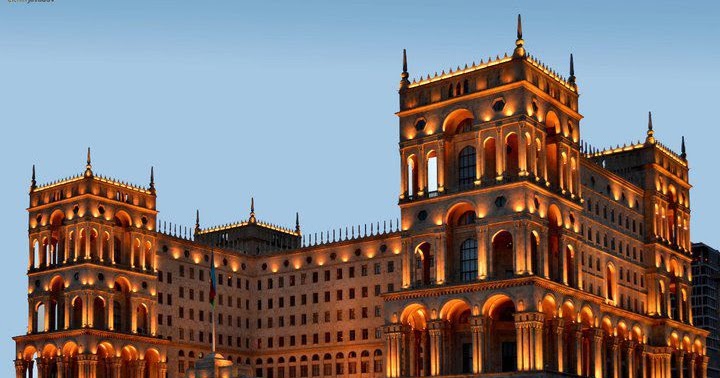
Атешгях Баку
Бакинский Атешгях, часто называемый «Бакинским храмом огня», представляет собой замковый религиозный храм в городе Сураханы (Сураханского района), пригороде Баку, Азербайджан.
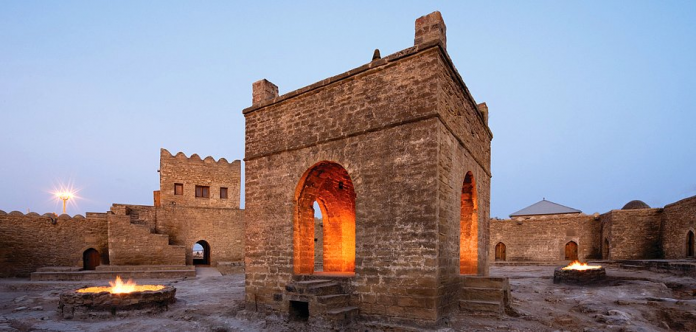
Судя по персидским и индийским надписям, храм использовался как место поклонения индуистов, сикхов и зороастрийцев. «Аташ» — персидское слово, обозначающее огонь. Пятиугольный комплекс с внутренним двором, окруженным кельями для монахов и четырехстолпным алтарем посередине, был построен в 17-18 веках. Он был заброшен в конце 19 века, вероятно, из-за сокращения индейского населения в этом районе. Естественный вечный огонь погас в 1969 году, после почти столетия эксплуатации нефти и газа в этом районе, но теперь он зажжен газом, поступающим из близлежащего города.

Бакинский Атешгях был паломническим и философским центром зороастрийцев с северо-запада Индийского субконтинента, которые вели торговлю с Каспийским регионом по знаменитой «Большой магистрали». Четыре священных элемента их веры были: атеши (огонь), бади (воздух), аби (вода) и хеки (земля). Храм перестал быть местом отправления культа после 1883 года с устройством нефтеперерабатывающих заводов (промышленности) в Сураханах. Комплекс был превращен в музей в 1975 году. Ежегодное количество посетителей музея составляет 15 000 человек.
Пылающая гора (Янандаг)
Янар-Даг — это природный газовый костер, который постоянно горит на склоне холма на Абшеронском полуострове Каспийского моря недалеко от Баку, столицы Азербайджана (страны, которая сама известна как «Страна огней»). Пламя выбрасывается в воздух на 3 метра (9,8 фута) из тонкого пористого слоя песчаника.

Гобустанский национальный парк
Гобустанский государственный заповедник, расположенный к западу от поселка Гобустан, примерно в 40 милях (64 км) к юго-западу от центра Баку, был создан в 1966 году, когда этот регион был объявлен национальной исторической достопримечательностью Азербайджана в попытке сохранить древние резные изображения, грязь вулканы и газовые камни в регионе.
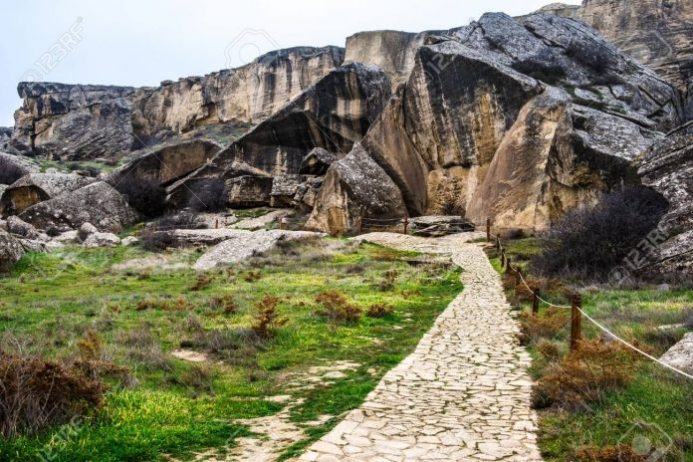
Гобустанский государственный заповедник очень богат археологическими памятниками, в заповеднике насчитывается более 6000 наскальных рисунков, на которых изображены люди, животные, батальные фигуры, ритуальные танцы, коррида, лодки с вооруженными гребцами, воины с копьями в руках, караваны верблюдов, картины. солнца и звезд, в среднем датируемых 5000-20000 лет.

Гобустанский государственный историко-культурный заповедник получил статус национального в 2006 году, а в 2007 году был внесен в Список всемирного социального наследия ЮНЕСКО.

Гарасу (грязевые) вулканы
В Азербайджане больше всего грязевых вулканов среди всех стран, которые широко распространены по всей стране. 350 из 700 вулканов мира находятся в Азербайджанской Республике
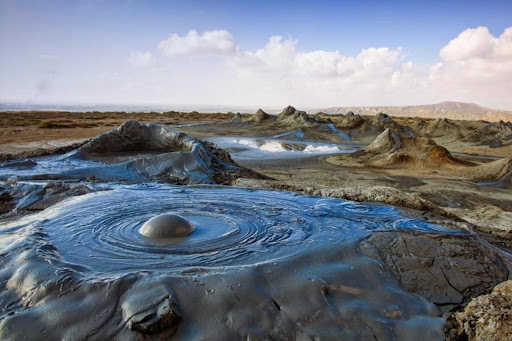
В Азербайджане также известны подземные и подводные грязевые вулканы. В Каспийском море насчитывается более 140 подводных вулканов. Восемь островов Бакинского архипелага по происхождению являются грязевыми вулканами. Другой вид грязевых вулканов – колодцы. Их деятельность можно наблюдать среди пластов разного возраста. Согласно информации, грязевые вулканы впервые начали свою деятельность на территории Азербайджана 25 миллионов лет назад.

Геологи НАСА, изучающие планету Марс, пришли к выводу, что грязевые вулканы Азербайджана имеют схожую структуру с возвышенностями Марса.
Бакинский бульвар (Бакинский бульвар), идущий параллельно Бакинскому побережью, был открыт в 1909 году. В начале прошлого века район, выбранный в качестве резиденции проживавшими в Баку нефтеторговцами, позже был назван Приморским национальным парком и взят под защитой.
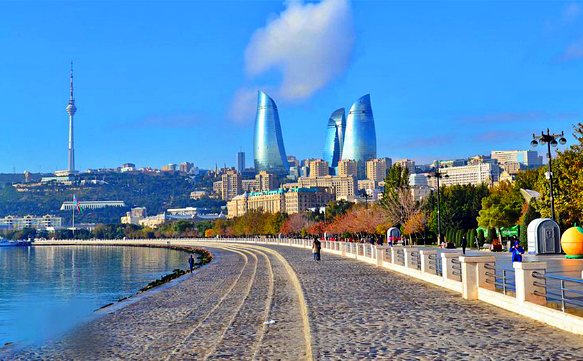
Бульвар, созданный заливом моря, после обретения независимости был расширен и превратился в центр притяжения с музеями, памятниками и развлекательными центрами.
Улица Низами
Улица Низами — большая пешеходная и торговая улица в центре Баку, Азербайджан, названная в честь классического персидского поэта Низами Гянджеви.

История улицы восходит к градостроительному проекту Баку 1864 года. Улица проходит через центр города с запада на восток. Начинается от улицы Абдуллы Шаига, в горной части города, и заканчивается у железнодорожного полотна на улице Сабита Оруджева, возле памятника шаху Исмаилу Хатаи в «Черном городе». Общая длина улицы составляет 3 538 м. Свободный от движения участок, который начинается от площади Фонтанов и заканчивается на улице Рашида Бейбутова, широко известен как Торговая («торговая улица» по-русски).

Улица Низами является домом для различных торговых точек, от банков до модных магазинов, и является одной из самых дорогих улиц в мире. На улице также находятся посольства Германии, Норвегии, Нидерландов и Австрии, а также Представительство Европейского Союза в Азербайджане. Ближайшие станции метро: «Сахиль» (красная ветка, к югу от улицы Низами) и «28 мая» (красная и зеленая ветки, к северу от улицы).

Азербайджанский Национальный Музей Ковра
Азербайджанский национальный музей ковра - это музей, расположенный в Баку, в котором представлены азербайджанские ковры и коврики различных техник ткачества и материалов разных периодов. Здесь находится самая большая коллекция азербайджанских ковров в мире. Впервые открывшийся на проспекте Нефтяников в 1967 году, он переехал в новое здание в приморском парке Баку в 2014 году.
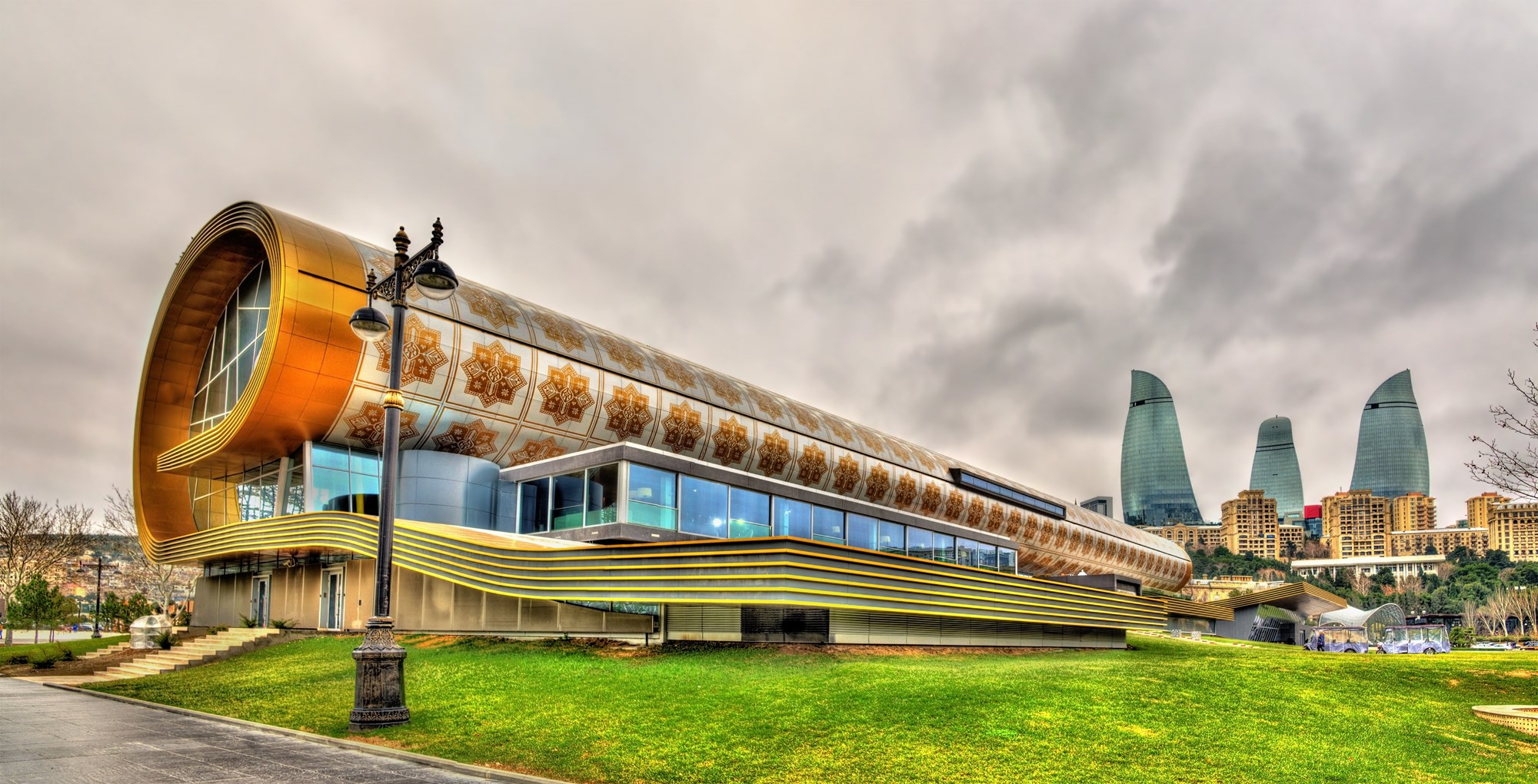
Международная и культурная деятельность
Город является научным, культурным и промышленным центром Азербайджана. стать важной площадкой для международных мероприятий. Он принимал 57-й конкурс песни «Евровидение» в 2012 году, Европейские игры 2015 года, 4-е Исламские игры солидарности, Гран-при Европы в 2016 году, Гран-при Азербайджана с 2017 года, принимал финал Лиги Европы УЕФА 2018–19 и был одним из Города-организаторы Евро-2020.
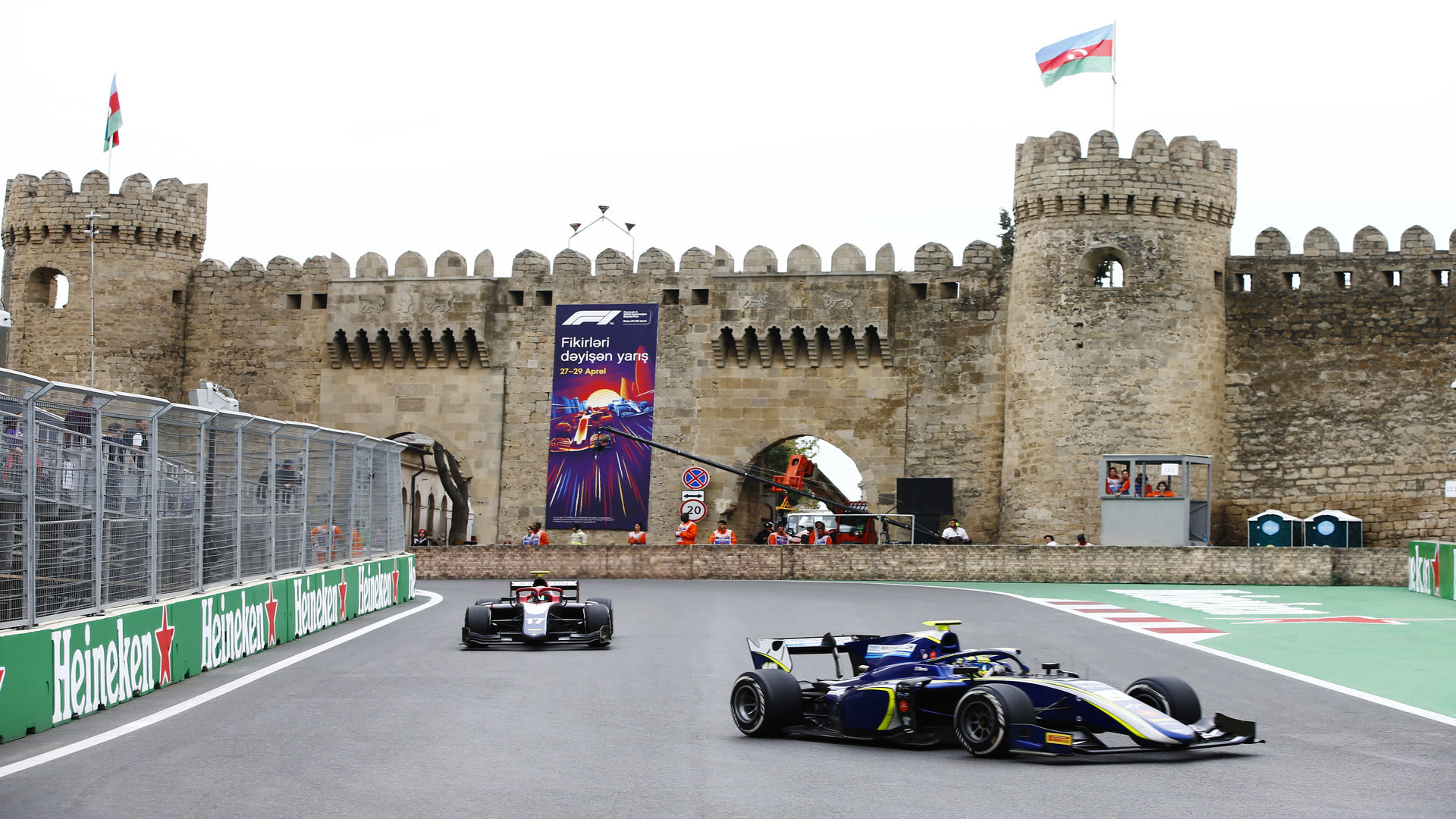
Participating Countries ICMeHeLS





















































